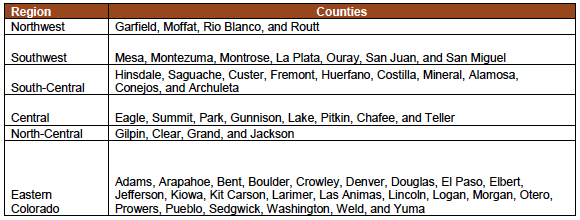| Economic Contribution of Off-Highway Vehicle Recreation in Colorado
EXECUTIVE SUMMARY Submitted to: Submitted by: August 2013 Introduction Households4 that Participate in Motorized Recreation Figure ES-1. Annual Resident OHV Registrations in Colorado Figure ES-2. Annual Resident Snowmobile Registrations in Colorado The number of registrations and permits was used in part to estimate the number of resident and non-resident households that likely participated in motorized recreation in Colorado during the 2012-13 season. Permit information is used to estimate the number of non-resident households coming to Colorado for motorized recreation. Between 2008 and 2012, non-resident OHV permits grew by more than 34 percent. The analysis shows that almost 150,000 resident households likely participated in some sort of motorized recreation in the 2012-13 season in Colorado, and approximately 36,000 non-resident households traveled to Colorado to participate in motorized recreation. The resident and non-resident household estimates are summarized in Table ES-1. Table ES-1. Estimated Population of Households Who Used OHVs and Snowmobiles for Motorized Recreation in Colorado in 2012-13 Season Expenditures Associated with Motorized Recreation During the 2012-13 season, Louis Berger estimated that motorized recreational enthusiasts spent more than $602 million while taking trips using their motorized vehicle for recreational purposes. On a household basis, residents spent on average $109 to $137 per day trip and $441 to $679 per overnight trip. Non-residential households spent on average $131 to $197 per day trip and $926 to $1,660 per overnight trip.5 More than 90 percent of these expenditures occurred during the summer OHV recreational season. In addition to spending money on day and overnight trips, households participating in motorized recreation also spend money on new vehicles, maintenance, repairs, accessories, storage, and miscellaneous items associated with their vehicles. Louis Berger estimated that motorized recreational enthusiasts spent more than $387.6 million annually on various items to support and enhance their experiences in Colorado, including $133 million in new vehicle purchases. On average, resident households spent between $574 and $4,116 on annual expenditures in Colorado. Non-resident households spent on average between $124 and $665 in annual expenditures in Colorado.6 In total, motorized recreational enthusiasts were responsible for $990 million in direct expenditures related to motorized recreation in Colorado during the 2012-13 season. Direct Labor, Income, and Tax Contributions The expenditures made by motorized-recreation enthusiasts have an economic contribution that supports businesses throughout the state. Total direct gross sales of $481 million associated with motorized recreation supported almost 5,500 direct jobs, $212 million in labor income (employee compensation and proprietor income), $284 million in gross regional product, and $35 million in federal, state, and local business taxes during the 2012-13 season (Table ES-2). It should be noted that there is a considerable difference between the direct expenditures ($990 million) discussed above and the direct sales effect ($481 million) on Colorado. Although motorized enthusiasts spend $990 on various expenditures within the state, their direct contribution to sales is $481 million. This is due to fact that retail purchases are margined in the IMPLAN model. Margins represents the difference between producer and purchaser prices in a retail or wholesale environment, and IMPLAN provides an allocation of retail spending to the appropriate manufacturing, retail and wholesale trade sectors, and transportation industries. For example, for the new vehicle purchases, IMPLAN only applies the margined amount or the mark-up that the retail establishment receives when selling the vehicle and reduces portion of sales allocated to the manufacturing component. Table ES-2. Direct Economic Impact of Motorized Recreation in Colorado during the 2012-13 Season Additional Economic Activity Direct expenditures made by motorized recreational enthusiasts have an additional effect by generating indirect and induced (downstream) economic activity often known as multiplier effects. The downstream economic effects of motorized recreation resulted in $465 million in downstream gross sales, 3,372 additional jobs, $160 million in additional labor income, $278 million in gross state product, and $24 million in federal, state, and local business taxes (Table ES-3). Table ES-3. Additional Economic Activity Resulting from Motorized Recreation in Colorado During the 2012-2013 Season Total Economic Contribution within Colorado The total economic contribution of motorized recreation for the 2012-13 season is summarized in Table ES-4. Motorized recreational enthusiasts are estimated to have supported more than $481 million in total direct gross sales for motorized recreation throughout the year. This direct spending supported an additional $465 million in downstream gross sales due to additional economic activity, or $945 million in total gross sales. Motorized recreation in Colorado is directly or indirectly responsible for almost 9,000 jobs and $373 million in labor income. According to gross sales, OHVs contribute 91 percent of economic contribution while snowmobiles contribute 9 percent. Table ES-4. Total Economic Contribution of Motorized Recreation in Colorado during the 2012-13 Season (Direct, Indirect, and Induced) Regional Economic Contribution Analysis The economic contribution of motorized recreation in different regions of the state was also evaluated (see Table ES-5). This included OHV and snowmobile trip spending by region. Table ES-6 summarizes the economic contribution by region. The region receiving the largest economic contribution from motorized recreation during the 2012-13 season was central Colorado. This region was followed in importance by south-central and southwest regions. Table ES-5. Regions in Colorado Used to Estimate Motorized Recreational Use Table ES-6. Estimated Economic Contribution of Motorized Recreation by Region in Colorado for the 2012-2013 Season –See the downloadable PDF above for this table– 1 Motorized recreation is defined for this study as the use of motorized vehicles on roads and trails which are not considered as part of the normal transportation network. The system of trails and roads used for this type of recreation are thus considered “off-highway”. |







